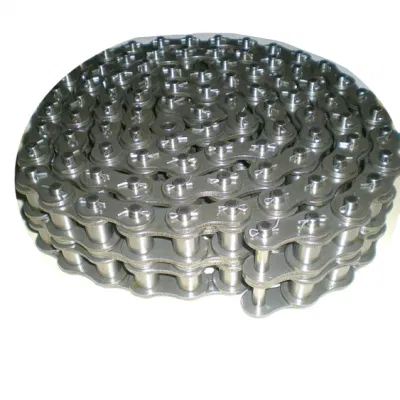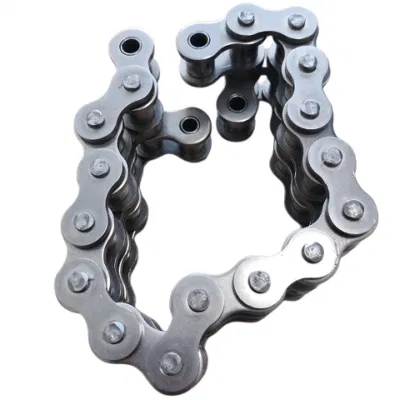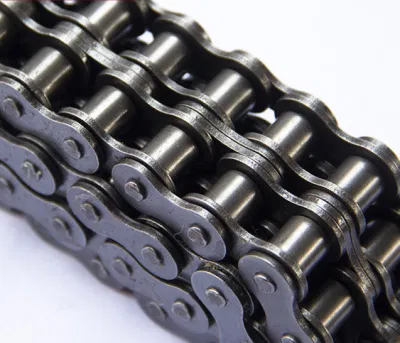Product Description
|
Chain No. |
Pitch
P |
Roller diameter
d1max |
Width between inner plates b1min mm |
Pin diameter
d2max |
Pin length | Inner plate depth h2max mm |
Plate thickness
t/Tmax |
Transverse pitch
Pt |
Breaking load
Q |
Weight per meter q kg/m |
|
| Lmax mm |
Lcmax mm |
||||||||||
| #06BSS-2 | 9.525 | 6.35 | 5.72 | 3.28 | 23.40 | 24.40 | 8.20 | 1.30 | 10.24 | 11.8/2653 | 0.87 |
*Bush chain:d1 in the table indicates the external diameter of the bush
*Straight side plates
Stainless steel chains are suitable for corrosive conditions involving food,chemicals pharmaceuticals,etc.and also suitable for high and low temperature conditions.
Chain Pictures
Roller chain
Roller chain or bush roller chain is the type of chain drive most commonly used for transmission of mechanical power on many kinds of domestic, industrial and agricultural machinery, including conveyors, wire- and tube-drawing machines, printing presses, cars, motorcycles, and bicycles. It consists of a series of short cylindrical rollers held together by side links. It is driven by a toothed wheel called a sprocket. It is a simple, reliable, and efficient[1] means of power transmission.
Though CHINAMFG Renold is credited with inventing the roller chain in 1880, sketches by Leonardo da Vinci in the 16th century show a chain with a roller bearing.
Construction of the chain
Two different sizes of roller chain, showing construction.
There are 2 types of links alternating in the bush roller chain. The first type is inner links, having 2 inner plates held together by 2 sleeves or bushings CHINAMFG which rotate 2 rollers. Inner links alternate with the second type, the outer links, consisting of 2 outer plates held together by pins passing through the bushings of the inner links. The “bushingless” roller chain is similar in operation though not in construction; instead of separate bushings or sleeves holding the inner plates together, the plate has a tube stamped into it protruding from the hole which serves the same purpose. This has the advantage of removing 1 step in assembly of the chain.
The roller chain design reduces friction compared to simpler designs, resulting in higher efficiency and less wear. The original power transmission chain varieties lacked rollers and bushings, with both the inner and outer plates held by pins which directly contacted the sprocket teeth; however this configuration exhibited extremely rapid wear of both the sprocket teeth, and the plates where they pivoted on the pins. This problem was partially solved by the development of bushed chains, with the pins holding the outer plates passing through bushings or sleeves connecting the inner plates. This distributed the wear over a greater area; however the teeth of the sprockets still wore more rapidly than is desirable, from the sliding friction against the bushings. The addition of rollers surrounding the bushing sleeves of the chain and provided rolling contact with the teeth of the sprockets resulting in excellent resistance to wear of both sprockets and chain as well. There is even very low friction, as long as the chain is sufficiently lubricated. Continuous, clean, lubrication of roller chains is of primary importance for efficient operation as well as correct tensioning.
Lubrication
Many driving chains (for example, in factory equipment, or driving a camshaft inside an internal combustion engine) operate in clean environments, and thus the wearing surfaces (that is, the pins and bushings) are safe from precipitation and airborne grit, many even in a sealed environment such as an oil bath. Some roller chains are designed to have o-rings built into the space between the outside link plate and the inside roller link plates. Chain manufacturers began to include this feature in 1971 after the application was invented by Joseph Montano while working for Whitney Chain of Hartford, Connecticut. O-rings were included as a way to improve lubrication to the links of power transmission chains, a service that is vitally important to extending their working life. These rubber fixtures form a barrier that holds factory applied lubricating grease inside the pin and bushing wear areas. Further, the rubber o-rings prevent dirt and other contaminants from entering inside the chain linkages, where such particles would otherwise cause significant wear.[citation needed]
There are also many chains that have to operate in dirty conditions, and for size or operational reasons cannot be sealed. Examples include chains on farm equipment, bicycles, and chain saws. These chains will necessarily have relatively high rates of wear, particularly when the operators are prepared to accept more friction, less efficiency, more noise and more frequent replacement as they neglect lubrication and adjustment.
Many oil-based lubricants attract dirt and other particles, eventually forming an CHINAMFG paste that will compound wear on chains. This problem can be circumvented by use of a “dry” PTFE spray, which forms a solid film after application and repels both particles and moisture.
Use
An example of 2 ‘ghost’ sprockets tensioning a triplex roller chain system
Roller chains are used in low- to mid-speed drives at around 6-0-0. p. 211. Retrieved 17 May 2-0-0. p. 86. Retrieved 30 January 2015.
Green 1996, pp. 2337-2361
“ANSI G7 Standard Roller Chain – Tsubaki Europe”. Tsubaki Europe. Tsubakimoto Europe B.V. Retrieved 18 June 2.
External links
Wikimedia Commons has media related to Roller chains.
The Complete Xihu (West Lake) Dis. to Chain
Categories: Chain drivesMechanical power transmissionMechanical power control
Products Package
Company Certificates
Why Choose Us
1. Reliable Quality Assurance System
2. Cutting-Edge Computer-Controlled CNC Machines
3. Bespoke Solutions from Highly Experienced Specialists
4. Customization and OEM Available for Specific Application
5. Extensive Inventory of Spare Parts and Accessories
6. Well-Developed CHINAMFG Marketing Network
7. Efficient After-Sale Service System
/* January 22, 2571 19:08:37 */!function(){function s(e,r){var a,o={};try{e&&e.split(“,”).forEach(function(e,t){e&&(a=e.match(/(.*?):(.*)$/))&&1
| Standard or Nonstandard: | Standard, Standard |
|---|---|
| Application: | Textile Machinery, Garment Machinery, Electric Cars, Motorcycle, Food Machinery, Agricultural Machinery, Textile Machinery, Garment Machinery, Conveyer Equipment, Packaging Machinery, Electric Cars, Motorcycle, Food Machinery, Marine, Mining Equipment, Agricultural Machinery, Car, Food and Beverage Industry, Motorcycle Parts |
| Surface Treatment: | Polishing, Polishing |
| Structure: | Roller Chain, Rotransmission Chain, Pulling Chain, Driving Chain |
| Material: | Stainless Steel, Rubber |
| Type: | Bush Chain, Transmission Chain, Pulling Chain, Driving Chain |
| Samples: |
US$ 0/Meter
1 Meter(Min.Order) | |
|---|
| Customization: |
Available
| Customized Request |
|---|

How does a bush chain handle reverse rotations and backdrives?
A bush chain is designed to handle reverse rotations and backdrives effectively. Here’s how it works:
1. Non-Slip Design: Bush chains are typically constructed with interlocking link plates and precision-fitted bushings. This design ensures that the chain maintains a positive engagement with the sprockets, preventing slippage or disengagement during reverse rotations or backdrives.
2. Tooth Profile: The sprockets used with bush chains are designed with a specific tooth profile that helps in maintaining proper chain engagement even during reverse rotations. The tooth shape ensures a smooth transition of the chain from one tooth to another, minimizing the risk of skipping or jumping off the sprocket.
3. Backstop Mechanisms: In some applications where backdrives or reverse rotations are more common, additional backstop mechanisms may be employed. These mechanisms prevent the chain from moving in the undesired direction by utilizing devices such as one-way clutches or backstop sprockets.
4. Proper Chain Tension: Maintaining proper chain tension is crucial for reliable operation in reverse rotations and backdrives. Adequate tension ensures that the chain remains engaged with the sprockets and minimizes the possibility of slippage.
Overall, bush chains are designed to handle reverse rotations and backdrives without compromising their performance and reliability. However, it is important to consider the specific application requirements and consult with chain manufacturers or experts to ensure the selection of the appropriate bush chain design and components for the desired operating conditions.

How does a bush chain contribute to overall system efficiency?
A bush chain contributes to overall system efficiency in several ways:
1. Power transmission: Bush chains are designed to efficiently transmit power from the driving source to the driven machinery or equipment. They have high tensile strength and can effectively transfer rotational motion, allowing for the efficient transfer of power from the motor or engine to the intended application.
2. Load-bearing capacity: Bush chains are capable of handling heavy loads and are designed to withstand the stresses associated with transmitting power in industrial applications. By efficiently transferring the load, they minimize power losses and reduce the need for additional components or systems.
3. Smooth and reliable operation: Bush chains are constructed with precision-engineered components that work together to provide smooth and reliable operation. They have low friction between the bushings and pins, reducing energy losses and minimizing wear and tear. This results in improved overall system efficiency.
4. Minimal maintenance requirements: Bush chains are designed to operate with minimal maintenance. They have self-lubricating capabilities, reducing the need for frequent lubrication. This not only saves time and resources but also ensures consistent performance and extends the chain’s lifespan.
5. Flexibility and adaptability: Bush chains can be customized and adapted to suit specific application requirements. They are available in various sizes, pitches, and configurations, allowing for easy integration into different systems. This flexibility enhances system efficiency by providing the optimal chain solution for the specific application.
Overall, a properly selected and maintained bush chain contributes to the overall efficiency of a system by minimizing power losses, reducing wear and tear, and providing reliable and smooth operation. It ensures effective power transmission and load-bearing capacity, resulting in improved productivity and reduced downtime.

How do you select the right bush chain for your application?
Choosing the right bush chain for your application is essential to ensure optimal performance and longevity. Here are some factors to consider when selecting a bush chain:
1. Load Capacity: Evaluate the maximum load that the chain will need to transmit. Consider factors such as weight, acceleration, and shock loads. Choose a bush chain with a load capacity that exceeds the anticipated load to ensure reliable operation.
2. Speed: Determine the operating speed of the chain. Higher speeds may require chains with specialized designs to minimize wear, reduce friction, and maintain accurate timing.
3. Environmental Conditions: Assess the environmental conditions in which the chain will operate. Consider factors such as temperature, humidity, dust, chemicals, and exposure to corrosive substances. Select a bush chain that is designed to withstand the specific conditions of your application.
4. Size and Configuration: Determine the required chain size based on the available space and the dimensions of the sprockets or pulleys. Consider the pitch, width, and overall dimensions of the chain. Additionally, assess whether a standard or custom configuration is needed to meet the application requirements.
5. Lubrication Requirements: Determine the lubrication method and frequency required for the chain. Some bush chains are self-lubricating, while others may require regular lubrication. Consider the availability of lubrication systems and the maintenance requirements of the chain.
6. Reliability and Durability: Assess the expected operational lifespan and the reliability requirements of your application. Look for bush chains from reputable manufacturers known for producing high-quality, durable products. Consider factors such as wear resistance, fatigue strength, and overall reliability.
7. Cost: Evaluate the cost-effectiveness of the bush chain, considering both the initial investment and long-term maintenance costs. Balance the performance requirements with the available budget.
Consult with a knowledgeable supplier or engineer to ensure you select the right bush chain that meets your specific application requirements. They can provide guidance based on their expertise and help you choose a chain that offers optimal performance and durability.


editor by CX 2024-04-11
